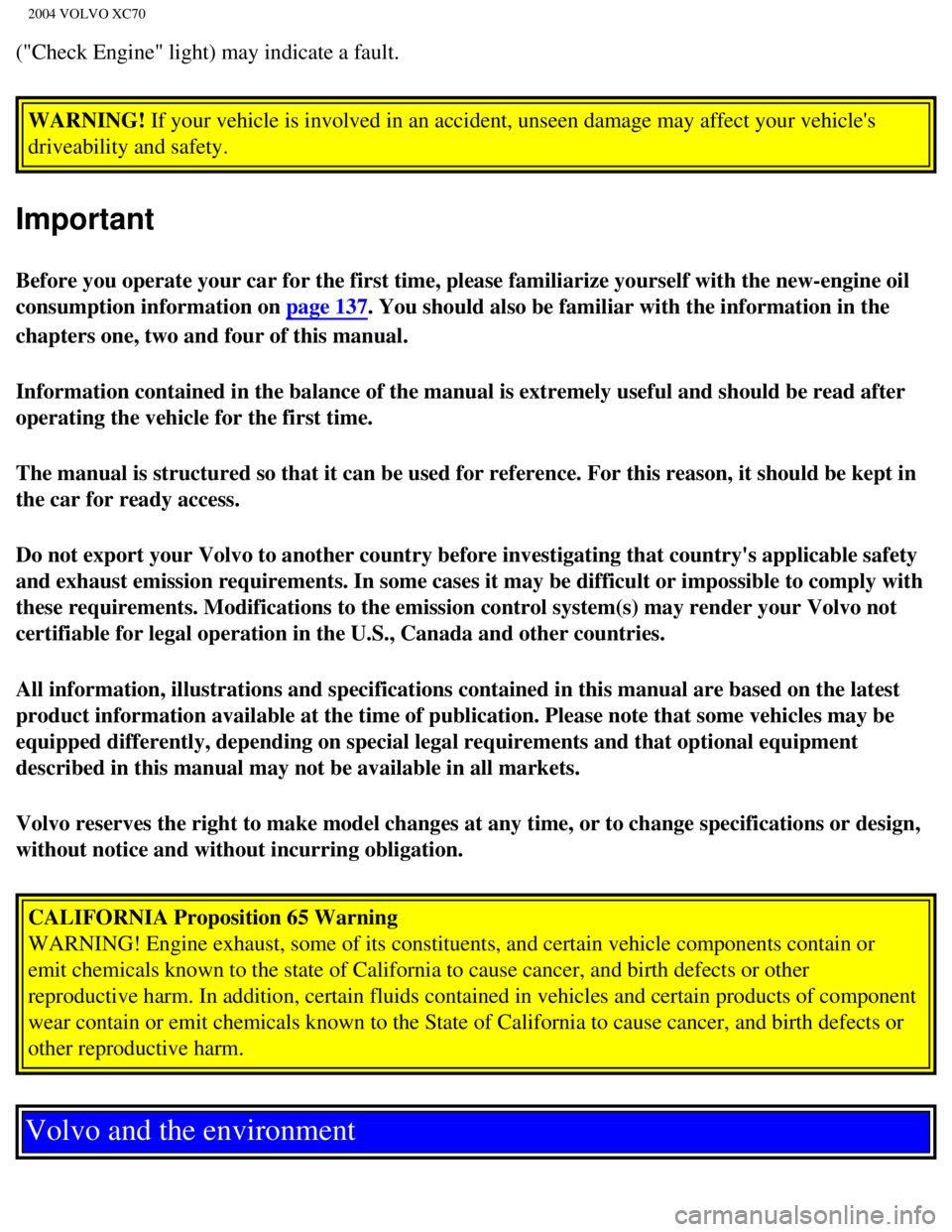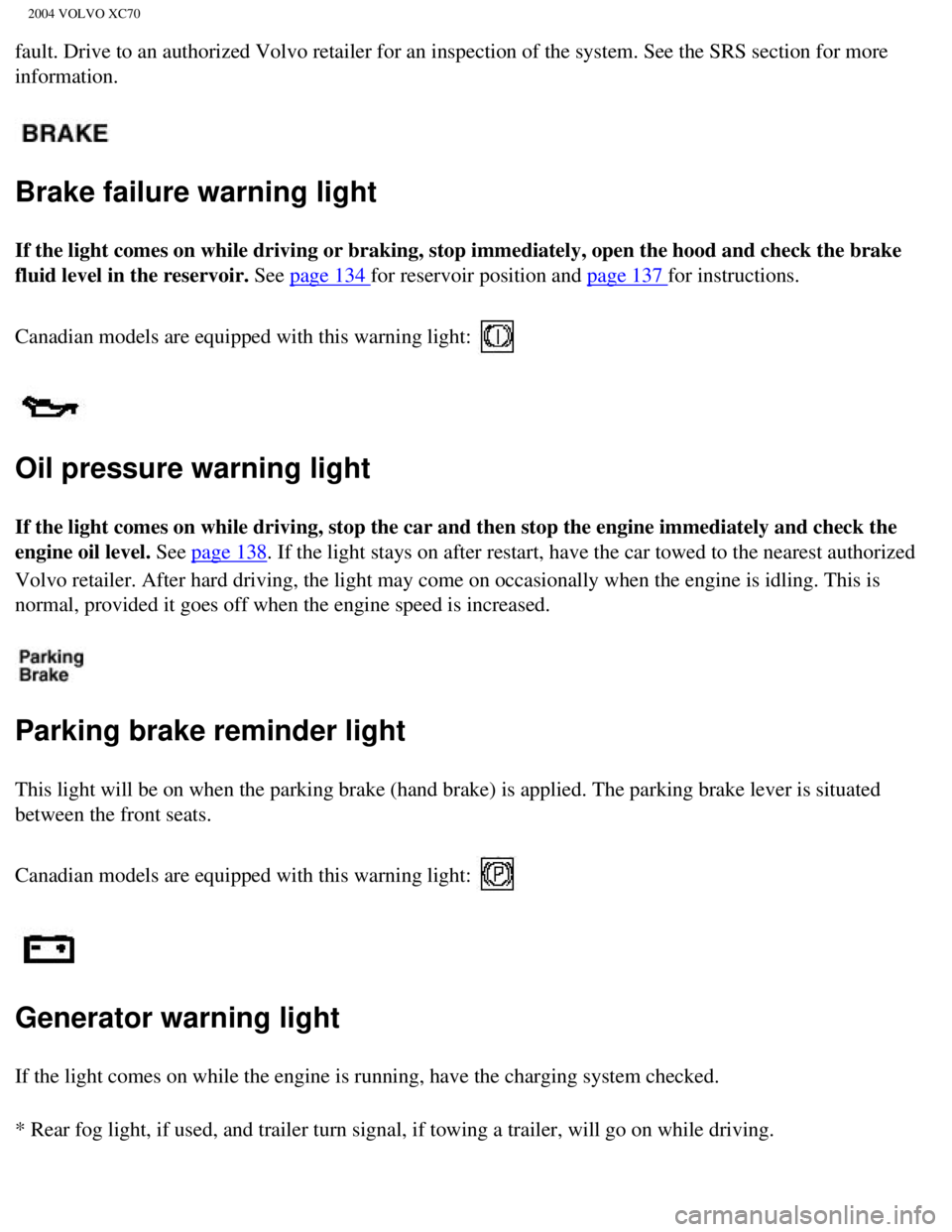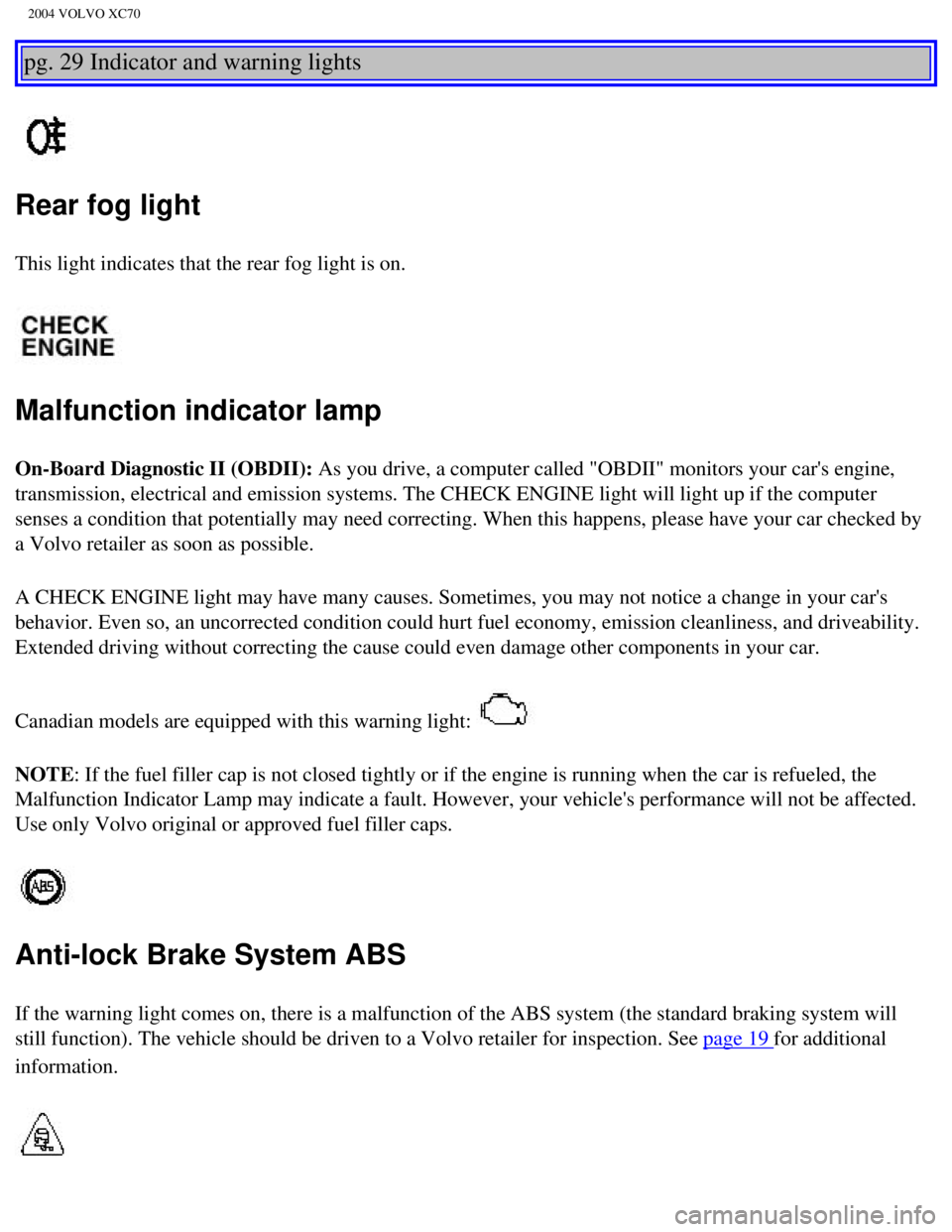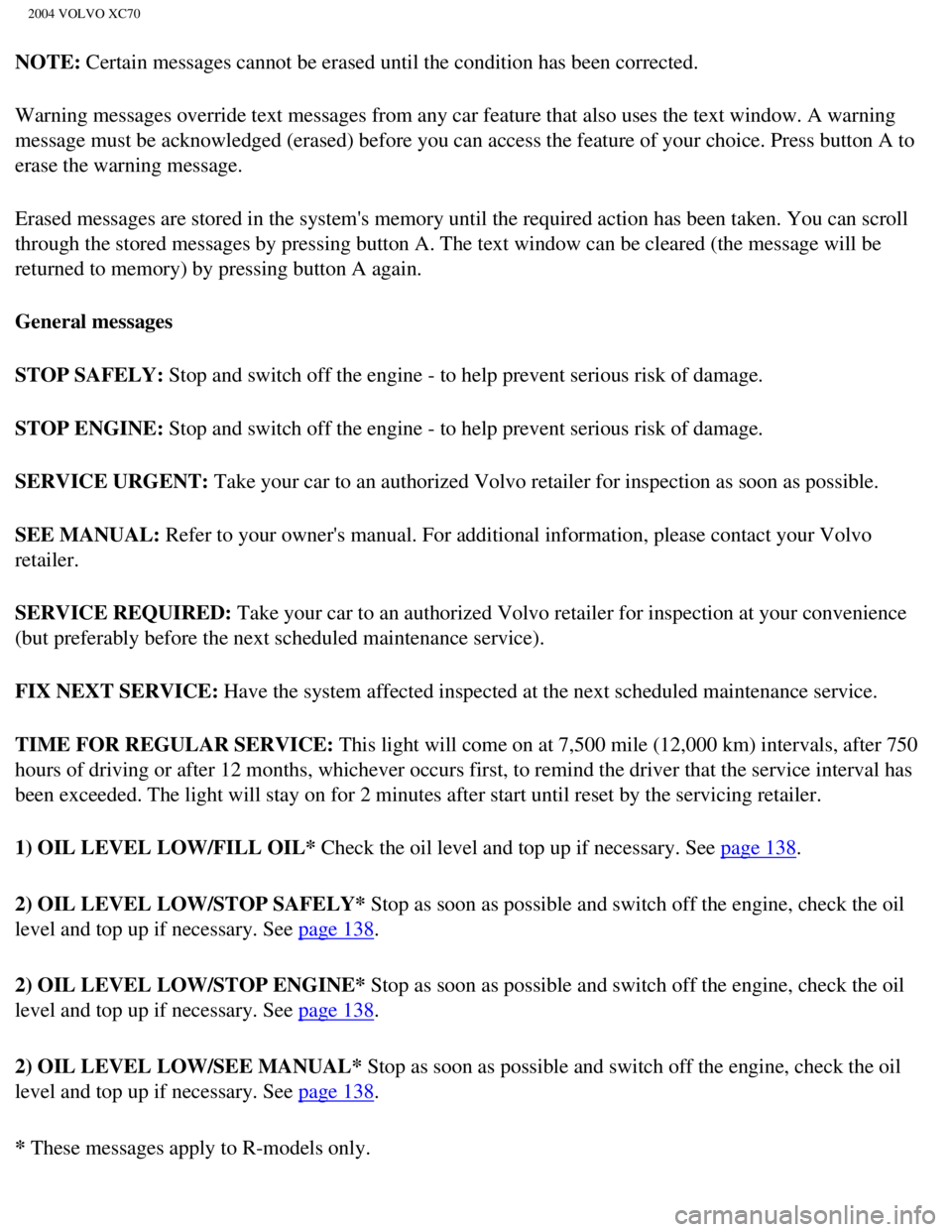check engine light VOLVO XC70 2004 Owners Manual
[x] Cancel search | Manufacturer: VOLVO, Model Year: 2004, Model line: XC70, Model: VOLVO XC70 2004Pages: 241, PDF Size: 5.78 MB
Page 4 of 241

2004 VOLVO XC70
("Check Engine" light) may indicate a fault. WARNING! If your vehicle is involved in an accident, unseen damage may affect yo\
ur vehicle's
driveability and safety.
Important
Before you operate your car for the first time, please familiarize yours\
elf with the new-engine oil
consumption information on
page 137. You should also be familiar with the information in the
chapters one, two and four of this manual.
Information contained in the balance of the manual is extremely useful a\
nd should be read after
operating the vehicle for the first time.
The manual is structured so that it can be used for reference. For this \
reason, it should be kept in
the car for ready access.
Do not export your Volvo to another country before investigating that co\
untry's applicable safety
and exhaust emission requirements. In some cases it may be difficult or \
impossible to comply with
these requirements. Modifications to the emission control system(s) ma\
y render your Volvo not
certifiable for legal operation in the U.S., Canada and other countries.\
All information, illustrations and specifications contained in this manu\
al are based on the latest
product information available at the time of publication. Please note th\
at some vehicles may be
equipped differently, depending on special legal requirements and that o\
ptional equipment
described in this manual may not be available in all markets.
Volvo reserves the right to make model changes at any time, or to change\
specifications or design,
without notice and without incurring obligation.
CALIFORNIA Proposition 65 Warning
WARNING! Engine exhaust, some of its constituents, and certain vehicle c\
omponents contain or
emit chemicals known to the state of California to cause cancer, and bir\
th defects or other
reproductive harm. In addition, certain fluids contained in vehicles and\
certain products of component
wear contain or emit chemicals known to the State of California to cause\
cancer, and birth defects or
other reproductive harm.
Volvo and the environment
file:///K|/ownersdocs/2004/2004_XC70/04xc70_00.htm (4 of 6)12/30/2006 \
4:32:53 PM
Page 13 of 241

2004 VOLVO XC70
the SRS warning lamp should light up when the ignition key is turned to \
positions I, II or III and should
go out after 7 seconds or when the engine is started. Check that this li\
ght is functioning properly every
time the car is started.
The following items are monitored by the self-diagnostic system:
l Sensor unit
l Cable harness
l Gas generator igniters
WARNING!
l Never drive an SRS equipped car with your hands on the steering wheel pa\
d / airbag housing.
l No objects, accessory equipment or stickers may be placed on, attached t\
o or installed near the
SRS cover in the center of the steering wheel, the SRS cover above the g\
love compartment or the area
affected by airbag deployment.
l If the SRS warning light stays on after the engine has started or if it \
comes on while you are
driving, drive the car to the nearest authorized Volvo retailer for insp\
ection as soon as possible.
There is no maintenance to perform on the SRS yourself. The month and ye\
ar shown on the decal on the
door pillar indicate when you should contact your Volvo retailer for spe\
cific servicing or replacement of
airbags and seat belt tensioners. This service must be performed by an a\
uthorized Volvo retailer.
Should you have any questions about the SRS system, please contact your \
authorized Volvo retailer or
Volvo Customer Support:
file:///K|/ownersdocs/2004/2004_XC70/04xc70_01a.htm (7 of 17)12/30/200\
6 4:32:54 PM
Page 33 of 241

2004 VOLVO XC70
motor vehicle safety from the Hotline.
Volvo strongly recommends that if your vehicle is covered under a servic\
e campaign, safety or emission
recall or similar action, it should be completed as soon as possible. Pl\
ease check with your local retailer
or Volvo Cars of North America, LLC. if your vehicle is covered under th\
ese conditions.
NHTSA can be reached at:
Internet :
http://www.nhtsa.dot.gov
Telephone:
1-888-DASH-2-DOT (1-888-327-4236) (toll free)
1-800-424-9393 (toll free)
1-202-366-0123 (in Washington DC area)
pg. 18 Brake system
Brake circuit malfunction
The brake system is a hydraulic system consisting of two master cylinder\
s and two separate brake
circuits. If a problem should occur in one of these circuits, it is stil\
l possible to stop the car with the other
brake circuit.
If the brake pedal must be depressed farther than normal and requires gr\
eater foot pressure, the stopping
distance will be longer.
A warning light in the instrument panel will light up to warn the driver\
that a fault has occurred.
If this light comes on while driving or braking, stop immediately and ch\
eck the brake fluid level in the
reservoir.
NOTE: Press the brake pedal hard and maintain pressure on the pedal - do not pump the brakes.
WARNING!
If the fluid level is below the MIN mark in the reservoir: DO NOT DRIVE.\
Tow the car to a Volvo
retailer and have the brake system inspected.
NOTE: When the car is at a standstill and the engine is idling, e.g. at a traf\
fic light and the brake pedal
is depressed, the pedal may go down slightly. This is normal and is caus\
ed by an built-in function in the
power brake system.
file:///K|/ownersdocs/2004/2004_XC70/04xc70_01b.htm (10 of 15)12/30/20\
06 4:32:55 PM
Page 34 of 241

2004 VOLVO XC70
Power brakes function only when the engine is running
The power brakes utilize vacuum pressure which is only created when the \
engine is running. Never let
the vehicle roll to a stop with the engine switched off.
If the power brakes are not working, the brake pedal must be pressed app\
roximately four times harder
than usual to make up for the lack of power assistance. This can happen \
for example when towing your
vehicle or if the engine is switched off when the vehicle is rolling. Th\
e brake pedal feels harder than
usual.
Water on brake discs and brake pads affects braking
Driving in rain and slush or passing through an automatic car wash can c\
ause water to collect on the
brake discs and pads. This will cause a delay in braking effect when the\
pedal is depressed. To avoid
such a delay when the brakes are needed, depress the pedal occasionally \
when driving through rain,
slush etc. This will remove the water from the brakes. Check that brake \
application feels normal. This
should also be done after washing or starting in very damp or cold weath\
er.
Severe strain on the brake system
The brakes will be subject to severe strain when driving in mountains or\
hilly areas or towing. Vehicle
speed is usually slower, which means that the cooling of the brakes is l\
ess efficient than when driving on
level roads. To reduce the strain on the brakes, shift into a lower gear\
and let the engine help with the
braking. Do not forget that, if you are towing a trailer, the brakes wil\
l be subjected to a greater than
normal load.
pg. 19 Anti-lock Brake System (ABS)
Anti-lock Brake System (ABS)
If the warning lamp lights up there is a malfunction of the ABS system (\
the standard braking system will
however function) and the vehicle should be driven cautiously to a Volv\
o retailer for inspection. The
Anti-lock Braking System (ABS) helps to improve vehicle control (stop\
ping and steering) during severe
braking conditions by limiting brake lockup. When the system "senses" im\
pending lockup, braking
pressure is automatically modulated in order to help prevent lockup, whi\
ch could lead to a skid.
The system performs a self-diagnostic test when the engine is started an\
d when the vehicle first
reaches a speed of approximately 12 mph (20 km/h). The brake pedal will pulsate several times and a
sound may be audible from the ABS control module. This is normal.
file:///K|/ownersdocs/2004/2004_XC70/04xc70_01b.htm (11 of 15)12/30/20\
06 4:32:55 PM
Page 35 of 241

2004 VOLVO XC70
To obtain optimal effect from the ABS system, constant pressure should b\
e kept on the brake
pedal, keep constant pressure on the brake pedal. Do not pump the brake \
pedal.
The switching of the ABS modulator will be audible and the brake pedal w\
ill pulsate during braking.
Please be aware that ABS does not increase the absolute braking potentia\
l of the vehicle. While control
will be enhanced, ABS will not shorten stopping distances on slippery su\
rfaces.
ABS with EBD (Electronic Brake Force Distribution)
EBD is an integrated part of the ABS system. EBD regulates the hydraulic\
pressure to the rear brakes to
help provide optimal braking capacity. The brake pedal will pulsate duri\
ng braking, which is normal.
If the BRAKE and ABS warning lights come on at the same time, this could\
indicate a fault in the
brake system.
l Stop the car in a suitable place and switch off the engine.
l Restart the engine.
l If both warning lights go off, no further action is required.
l If both lights are still on after the engine has been restarted, switch \
off the engine again and check the
brake fluid level (see
pages 139 and for the location of the brake fluid reservoir).
WARNING!
If the fluid level is below the MIN mark in the reservoir, DO NOT DRIVE.\
Have the car towed to an
authorized Volvo retailer and have the brake system inspected.
l If the brake fluid level is above the MIN mark, drive carefully to an au\
thorized Volvo retailer and
have the brake system inspected.
pg. 20 STC/DSTC
Stability Traction Control (STC)*/ Dynamic Stability Traction
Control (DSTC)**
* Standard on all models except the T5 turbo and R-models.
** Standard on T5 turbo and R-models, option on all other models
file:///K|/ownersdocs/2004/2004_XC70/04xc70_01b.htm (12 of 15)12/30/20\
06 4:32:55 PM
Page 43 of 241

2004 VOLVO XC70
information.
If the engine temperature remains high, check coolant level - see
page 133.
4 Trip odometer/reset button
The trip odometer is used for measuring shorter distances. The last digi\
t indicates 1/10 mile/kilometer. Press
the button quickly to toggle between trip odometers 1 and 2. Hold in the\
button for more than 2 seconds to
reset.
5 Odometer
6 Speedometer
7 General warning light (see
page 28).
8 High beam indicator light
9 Tachometer
Indicates engine speed in thousands of rpm. Do not drive for long with t\
he needle in the red section. The
engine has an built-in function preventing too high an engine speed. Whe\
n this function operates, you may
discern some pulsation, which is normal.
10 Gear and driving mode indicator
The currently selected driving mode is displayed here. If you use the Ge\
artronic function on the automatic
transmission, the currently selected gear will be displayed.
11 Ambient temperature indicator
This display indicates the air temperature outside your car. A "snowflak\
e" symbol in the text window is
displayed when the temperature is in the range of 23 - 36° F (-5 - +\
2° C).
Please note that this symbol does not indicate a fault with your car.
At low speeds or when the car is not moving, the temperature readings ma\
y be slightly higher than the actual
ambient temperature.
12 Clock/reset button
Turn the button to adjust the clock.
13 Fuel gauge
The fuel tank holds approximately:
Front wheel drive models:18.5 US gal. (70 liters)
All Wheel Drive models: 19 US gal. (72 liters)
V70R: 18 US gal. (68 liters)
file:///K|/ownersdocs/2004/2004_XC70/04xc70_02a.htm (5 of 14)12/30/200\
6 4:32:56 PM
Page 45 of 241

2004 VOLVO XC70
fault. Drive to an authorized Volvo retailer for an inspection of the sy\
stem. See the SRS section for more
information.
Brake failure warning light
If the light comes on while driving or braking, stop immediately, open t\
he hood and check the brake
fluid level in the reservoir. See
page 134 for reservoir position and page 137 for instructions.
Canadian models are equipped with this warning light:
Oil pressure warning light
If the light comes on while driving, stop the car and then stop the engi\
ne immediately and check the
engine oil level. See
page 138. If the light stays on after restart, have the car towed to the nearest\
authorized
Volvo retailer. After hard driving, the light may come on occasionally w\
hen the engine is idling. This is
normal, provided it goes off when the engine speed is increased.
Parking brake reminder light
This light will be on when the parking brake (hand brake) is applied. \
The parking brake lever is situated
between the front seats.
Canadian models are equipped with this warning light:
Generator warning light
If the light comes on while the engine is running, have the charging sys\
tem checked.
* Rear fog light, if used, and trailer turn signal, if towing a trailer,\
will go on while driving.
file:///K|/ownersdocs/2004/2004_XC70/04xc70_02a.htm (7 of 14)12/30/200\
6 4:32:56 PM
Page 46 of 241

2004 VOLVO XC70
pg. 29 Indicator and warning lights
Rear fog light
This light indicates that the rear fog light is on.
Malfunction indicator lamp
On-Board Diagnostic II (OBDII): As you drive, a computer called "OBDII" monitors your car's engine,
transmission, electrical and emission systems. The CHECK ENGINE light wi\
ll light up if the computer
senses a condition that potentially may need correcting. When this happe\
ns, please have your car checked by
a Volvo retailer as soon as possible.
A CHECK ENGINE light may have many causes. Sometimes, you may not notice\
a change in your car's
behavior. Even so, an uncorrected condition could hurt fuel economy, emi\
ssion cleanliness, and driveability.
Extended driving without correcting the cause could even damage other co\
mponents in your car.
Canadian models are equipped with this warning light:
NOTE: If the fuel filler cap is not closed tightly or if the engine is runni\
ng when the car is refueled, the
Malfunction Indicator Lamp may indicate a fault. However, your vehicle's\
performance will not be affected.
Use only Volvo original or approved fuel filler caps.
Anti-lock Brake System ABS
If the warning light comes on, there is a malfunction of the ABS system \
(the standard braking system will
still function). The vehicle should be driven to a Volvo retailer for i\
nspection. See
page 19 for additional
information.
file:///K|/ownersdocs/2004/2004_XC70/04xc70_02a.htm (8 of 14)12/30/200\
6 4:32:56 PM
Page 48 of 241

2004 VOLVO XC70
NOTE: Certain messages cannot be erased until the condition has been corrected\
.
Warning messages override text messages from any car feature that also u\
ses the text window. A warning
message must be acknowledged (erased) before you can access the featur\
e of your choice. Press button A to
erase the warning message.
Erased messages are stored in the system's memory until the required act\
ion has been taken. You can scroll
through the stored messages by pressing button A. The text window can be\
cleared (the message will be
returned to memory) by pressing button A again.
General messages
STOP SAFELY: Stop and switch off the engine - to help prevent serious risk of damage\
.
STOP ENGINE: Stop and switch off the engine - to help prevent serious risk of damage\
.
SERVICE URGENT: Take your car to an authorized Volvo retailer for inspection as soon as \
possible.
SEE MANUAL: Refer to your owner's manual. For additional information, please contact\
your Volvo
retailer.
SERVICE REQUIRED: Take your car to an authorized Volvo retailer for inspection at your con\
venience
(but preferably before the next scheduled maintenance service).
FIX NEXT SERVICE: Have the system affected inspected at the next scheduled maintenance ser\
vice.
TIME FOR REGULAR SERVICE: This light will come on at 7,500 mile (12,000 km) intervals, after 750\
hours of driving or after 12 months, whichever occurs first, to remind t\
he driver that the service interval has
been exceeded. The light will stay on for 2 minutes after start until re\
set by the servicing retailer.
1) OIL LEVEL LOW/FILL OIL* Check the oil level and top up if necessary. See
page 138.
2) OIL LEVEL LOW/STOP SAFELY* Stop as soon as possible and switch off the engine, check the oil
level and top up if necessary. See
page 138.
2) OIL LEVEL LOW/STOP ENGINE* Stop as soon as possible and switch off the engine, check the oil
level and top up if necessary. See
page 138.
2) OIL LEVEL LOW/SEE MANUAL* Stop as soon as possible and switch off the engine, check the oil
level and top up if necessary. See
page 138.
* These messages apply to R-models only.
file:///K|/ownersdocs/2004/2004_XC70/04xc70_02a.htm (10 of 14)12/30/20\
06 4:32:56 PM
Page 128 of 241

2004 VOLVO XC70
Rear towing eyelet
Precautions when the car is in tow
l The steering wheel must be unlocked. Turn the ignition key to position I\
or II.
l The gear selector must be in position N.
l Maximum speed: 50 mph (80 km/h)
l Maximum distance with front wheels on ground: 50 miles (80 km).
l While the car is being towed, try to keep the tow rope taut at all times\
.
l Cars with an automatic transmission should only be towed in forward dire\
ction.
CAUTION:
l Please check with state and local authorities before attempting this typ\
e of towing, as vehicles being
towed are subject to regulations regarding maximum towing speed, length \
and type of towing device,
lighting, etc.
l If the car's battery is dead, do not attempt to start the vehicle by pus\
hing or pulling it as this will
damage the three-way catalytic converter(s). The engine must be jump s\
tarted using an auxiliary battery
(see
page 104).
l If the car is being towed on a flat bed truck, the towing eyelets must n\
ot be used to secure the car on
the flat bed. Consult the tow truck operator.
WARNING!
l Remember that the power brakes and power steering will not function when\
engine is not running.
The braking and steering systems will function but the brake pedal press\
ure required is 3 - 4 times
above normal and greater steering effort must be exerted.
l The towing eyelets must not be used for pulling another vehicle out of a\
ditch or for any similar
purpose involving severe strain.
l Do not use the towing eyelets to pull the car up onto a flat bed tow tru\
ck.
pg. 101 Vehicle towing information
file:///K|/ownersdocs/2004/2004_XC70/04xc70_06b.htm (2 of 10)12/30/200\
6 4:33:02 PM